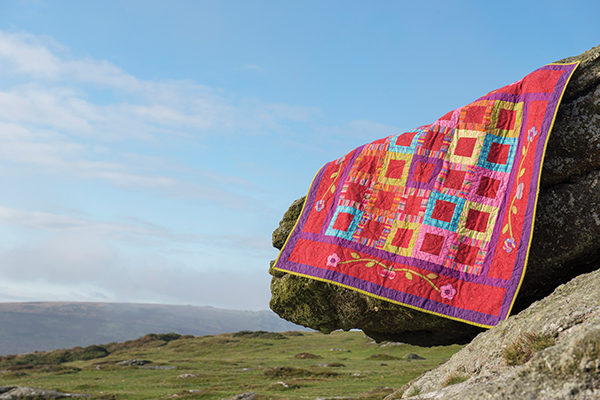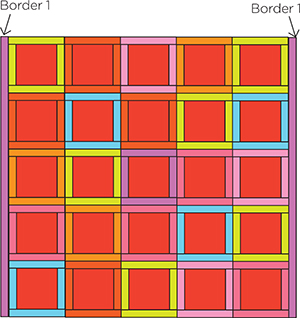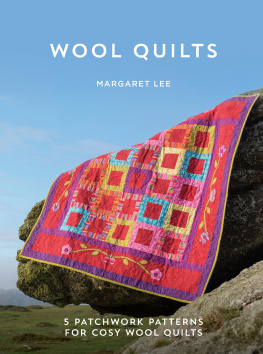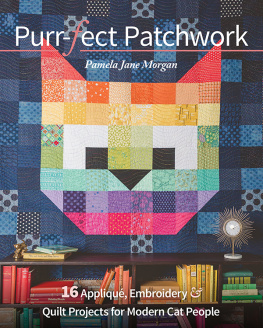Contents
Guide
WOOL QUILTS
MARGARET LEE

www.stitchcraftcreate.co.uk
For full sized downloadable templates please go to
http://ideas.stitchcraftcreate.co.uk/patterns/
DEDICATION
To my mother, Gloria, a continuing inspiration.
INTRODUCTION
Over 45 years ago I made myself a beautiful jacket out of Liberty cottons. I cut and hand stitched together dozens of fabric-covered paper hexagons to make enough fabric for me to cut and then stitch into a jacket. I still have the jacket, along with several of the little baby quilts I made for my children. I re-discovered quilting again almost 30 years later, and found there had been a revolution rotary blades, cutting mats, kits, coordinated fabrics and a myriad of books had transformed the world of quilting.
I cannot remember learning to sew. My mother was a very talented milliner and dressmaker and her sewing room was a magical and enticing space for little hands. My first reaction was always to the fabric, and its my love for fabric that is my mothers abiding legacy. Tweed (woven wool fabric) has an interesting place in the world of quilt makers. There are some beautiful examples of tweed quilts held in museums, but in more modern quilting it has only featured as a small part of a project, more particularly in folk-art quilts, and its usually been a felted wool and not a woven wool that has been used. I hope that this book will inspire you to look at this heritage fabric a little differently. The beautiful textures, colours and woven designs are wonderful to work with, and although there are a few differences between sewing with tweed compared to cotton, the end result more than justifies the effort.
In this book the quilts have been made using Imperial inches and although metric measurements have been provided, the best and most accurate results will be obtained by using inches, and a 38in seam allowance throughout piecing see for more advice. Before making any of the projects, please refer to Techniques: Cutting Wool Tweed and Techniques: Sewing with Wool Tweed.
In my quilting world I have always been drawn to colour, simple shapes, the story behind the quilt, and that elusive element, character. I would much rather view a quilt, mistakes and all, that told a story and held a place in history, than something exactly executed but without character. Quilt making should be enjoyable, easy, rewarding, and accommodate your own ability and talents. I sometimes wonder if I only piece fabric to create a background for appliqu I love the endless possibilities that appliqu provides. For me its like writing with fabric as the shapes and designs create the story of the quilt. My hope is that you will enjoy this book and that the designs will encourage you to experiment with this tactile and beautiful fabric.
HEARTS AND FLOWERS
The strong red of the wool tweed, mixed with brightly woven shot cottons, makes this a bright and colourful quilt. Cotton appliqu has also been added, making an attractive decoration. The medium-weight tweed lends itself very well to the design and its only on closer inspection that you realise that wool is the feature fabric in this project. The simple folk-art inspired appliqu design is mirrored on the tweed borders, and incorporates two of my favourite shapes hearts and flowers.
The quilt was designed, pieced and appliqud by Margaret Lee and long-arm quilted by Nicola Doherty-Roe
FABRIC REQUIREMENTS
- Medium-weight red wool tweed 1yd (1m) of 58in (147cm) wide
- Selection of woven cottons for blocks and appliqu about 112yd (1.5m) in total (I used eight different fabrics)
- Purple shot cotton for borders 12yd (0.5m)
- Fusible web for appliqu
- Red embroidery cotton (floss) or other colour of your choice
- Wadding (batting) 50in (127cm) square
- Backing fabric 234yd (2.5m)
- Citrus green shot cotton for binding 12yd (0.5m)
Finished size: 46in square (117cm) approx.
Use 38in (1cm) seam allowances and press all seams open, unless otherwise instructed

MAKING THE BLOCKS
There are twenty-five blocks in this quilt, and each block is made the same way. Cut twenty-five 414in (10.8cm) squares from the red tweed.
For the border on each block cut two strips of woven cotton, each 2in x 414in (5cm x 10.8cm). Pin these strips right sides together along the top and bottom of a red square and stitch in place using a 38in (1cm) seam. Press the seams open. Cut two further strips of woven cotton, each 2in x 634in (5cm x 17.1cm) for the sides of the square. Pin in place and stitch as before (). Press the seams open.
Fig 1


Repeat this process to make a further twenty-three blocks using the woven cottons to frame the red tweed. Make one further block using the purple shot cotton for the centre block of the quilt. This makes a total of twenty-five blocks.
When all blocks are made, lay them out in a pleasing arrangement of five rows each with five blocks and with the purple bordered block in the centre. Pin and then stitch the rows of blocks together using 38in (1cm) seams. Press the seams open. Now sew the rows together, taking care to match up the seams neatly. Press seams open as you add each row. Check the quilt measurement it should be 3034in (78.1cm) square at this stage. Trim stray threads.
MAKING BORDER 1
All of the border pieces are cut slightly longer than required and will be trimmed down later, once they are sewn to the quilt. From the purple shot cotton cut two strips to run along the outer side edges of the quilt centre. Cut these strips 214in (5.7cm) wide and about 31in (78.7cm) long. Pin in place, and carefully stitch in place, making sure not to stretch the tweed as you sew. Press seams open. Trim the edges level with the quilt ().
Fig 2

MAKING BORDER 2
From the red tweed cut two strips across the remaining width of the fabric, measuring 434in (12cm) wide and about 31in (78.7cm) long. Sew a long running stitch around the edges to help stop it fraying and keep it in shape as you stitch on the appliqu later. Find the halfway point along the long edge of these strips and mark with a pin, or a small stitch. These will be sewn to the sides of the quilt, but do not stitch into place yet set aside for the moment.
MAKING BORDER 3
From the purple shot cotton cut two strips to run along the top and bottom of the quilt, 214in (5.7cm) wide and about 43in (109cm) long set these strips aside for the moment.
MAKING BORDER 4
From the red tweed cut two strips that will run along the top and the bottom of the quilt, 434in (12cm) wide and about 43in (109cm) long. Sew a long running stitch around the outer edge of both strips and set them aside for the moment. As in the second border, find the halfway point along the long edge and mark with a pin or small stitch.



















